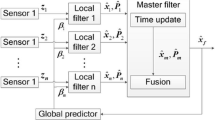Abstract
In modern navigation applications, Inertial Navigation System (INS) is attractive for integrating with Global Positioning System (GPS). Although traditional GPS/INS integrated systems can bridge the GPS gaps, the navigation capability is strongly dependent on the performances of standalone INS. As an important complementary, a new terrestrial, Radio-Frequency (RF) based, distance measurement technology “Locata” can provide continuously time-synchronised ranging signals even in many GPS challenged environments e.g. poor satellite geometry, signal blockage in suburban, tunnels, high rise buildings canyon. This paper investigates the integration of Locata, GPS, and INS with a focus on the loosely-coupled triple integration algorithm. Firstly, the Conventional Kalman Filtering (CKF) based triple integration of Locata/GPS/INS architecture is described and briefly discussed. Secondly, to overcome the pitfalls of conventional Locata/GPS/INS integration algorithm, an Adaptive Dual Kalman Filtering (ADKF) algorithm is proposed and developed in three stages: (1) To enhance the reliability of position and velocity (PV) quantities generated from Locata/GPS integrated sensors, the 1st KF is additionally constructed to reliably estimate the PV solution before fusing INS sensor. (2) Combining the 15-state INS error model and the measurements which are the differences between PV solution from the 1st KF and INS sensor, the 2nd KF is subsequently employed to correct the INS navigation errors. (3) The final integration solution is reversely used as the feedback for precisely estimating the stochastic model (i.e. variance of dynamic and observation model noise) of the 1st KF. Finally, the real flight experiment is carried out to demonstrate the efficiency and validity of Locata/GPS/INS integration algorithms. The results show that: (1) Conventional GPS/INS integration performs well but its accuracy dramatically decreases when GPS signals are unavailable for a short period. (2) Augmented by Locata, GPS/INS produces tolerable results in whole experiment even without aiding of GPS. (3) By additionally operation of the 1st KF and adaptively estimating its stochastic model with feedback of integration solution, ADKF achieves more accurate and reliable position, velocity and attitude (PVA) solution than CKF.
Access this chapter
Tax calculation will be finalised at checkout
Purchases are for personal use only
Similar content being viewed by others
References
Leick A (1995) GPS satellite surveying, 2nd edn. Wiley, New York
Kuusniemi H, Lachapelle G, Takala JH (2004) Positioning and velocity reliability testing in degraded GPS signal environments. GPS Solutions 8(4):226–237
Zhou Z, Shen Y, Li B (2011) Moving time-window based real-time estimation algorithm for the stochastic model of GPS/Doppler navigation. Acta Geodaetica et Cartographica Sinica 40(2):220–225
Zhou Z, Li Y, Rizos C, Shen Y (2009) A robust integration of GPS and MEMS-INS through trajectory-constrained adaptive Kalman filtering. In: Proceedings of ION GNSS 2009, Savannah, Georgia, pp 995–1003, 22–25 Sept
Godha S, Cannon ME (2007) GPS/MEMS-INS integrated system for navigation in urban areas. GPS Solutions 11(3):193–203
Dissanayake G, Sukkarieh S, Nebot E, Durrant-Whyte H (2001) The aiding of a low cost, strapdown inertial unit using modeling constraints in land vehicle applications. IEEE Trans Rob Autom 17(5):731–747
Gelb A (1974) Applied optimal estimation. The Massachusetts Institute of Technology Press, Massachusetts
Nassar S, Niu X, El-Sheimy N (2007) Land-vehicle INS/GPS accurate positioning during GPS signal blockage periods. J Surv Eng 133(3):134–143
Rizos C, Grejner-Brzezinska DA, Toth CK, Dempster AG, Li Y, Politi N, Barnes J, Sun H, Li L (2010) Hybrid positioning—a prototype system for navigation in GPS-challenged environments. GPS World 21(3):42–47
Li Y, Rizos C (2010) Seamless navigation through a Locata-enhanced GPS and INS integrated system. International symposium on GPS/GNSS, Taipei, Taiwan, pp 40–45, 26–28 October
Brown R, Hwang PYC (1997) Introduction to random signals and applied Kalman filtering. Wiley, New York
Zhou Z, Shen Y, Li B (2010) A windowing-recursive approach for GPS real-time kinematic positioning. GPS Solutions 14(4):365–373
Geng Y, Wang J (2008) Adaptive estimation of multiple fading factors in Kalman filter for navigation applications. GPS Solutions 12(4):273–279
Yang Y, He H, Xu G (2001) A new adaptively robust filtering for kinematic geodetic positioning. J Geodesy 75(2):109–116
Yang Y, Xu T (2003) An adaptive Kalman filter based on sage windowing weights and variance components. J Navig 56(2):231–240
Yang Y, Gao W (2005) Comparison of adaptive factors in Kalman Filter on navigation results. J Navig 58(3):471–478
Yang Y, Gao W (2006) An optimal adaptive Kalman filter. J Geodesy 80(4):177–183
Zhou Z, Li B, Shen Y (2013) A window-recursive approach for GNSS kinematic navigation using pseudorange and Doppler measurements. J Navig 66(2):295–313
Acknowledgments
This work was substantially supported in part by the Fundamental Research Funds for the Central Universities under Grant ZYGX2010J114 and by the State Key Laboratory of Information Engineering in Surveying, Map** and Remote Sensing, Wuhan University under Grant 10P01.
Author information
Authors and Affiliations
Corresponding author
Editor information
Editors and Affiliations
Rights and permissions
Copyright information
© 2013 Springer-Verlag Berlin Heidelberg
About this paper
Cite this paper
Zhou, Z., Yang, L., Li, Y. (2013). An Adaptive Dual Kalman Filtering Algorithm for Locata/GPS/INS Integrated Navigation. In: Sun, J., Jiao, W., Wu, H., Shi, C. (eds) China Satellite Navigation Conference (CSNC) 2013 Proceedings. Lecture Notes in Electrical Engineering, vol 245. Springer, Berlin, Heidelberg. https://doi.org/10.1007/978-3-642-37407-4_50
Download citation
DOI: https://doi.org/10.1007/978-3-642-37407-4_50
Published:
Publisher Name: Springer, Berlin, Heidelberg
Print ISBN: 978-3-642-37406-7
Online ISBN: 978-3-642-37407-4
eBook Packages: EngineeringEngineering (R0)




